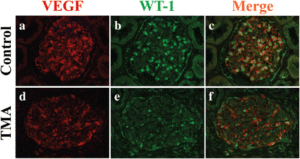A case report by a team of Washington University nephrologists and pathologists from Arkana Laboratories may prove valuable in directing future treatment of Castleman’s Disease (CD) with renal involvement. The report, published in the journal BMC Nephrology, describes a patient presenting with a very rare, aggressive form of multicentric CD with renal thrombotic microangiopathy (TMA).
CD is a rare disorder involving proliferation of cells in the lymphatic system, in which involvement of the kidney is not common. Proliferating plasma cells in the lymph nodes cause overproduction and elevated systemic levels of the cytokine interleukin-6 (IL-6) and vascular endothelial growth factor (VEGF), which are implicated in the pathophysiology of the disorder.
The team, led by Ying Maggie Chen, MD, PhD, was the first to perform dual immunofluorescent staining of VEGF and the podocyte nucleus marker WT-1 in a kidney biopsy and correlate the results with serum VEGF levels in a patient.

Anubha Mutneja, MD
“Markedly elevated serum VEGF levels were associated with podocyte VEGF down regulation in TMA,” says Anubha Mutneja, MD, a previous fellow in the Division of Nephrology and first author of the case report. How overproduction of VEGF and IL-6 leads to decreased podocyte VEGF expression needs further investigation.
Chemotherapy with Rituximab, Etoposide, Cyclophosphamide, Vincristine and Prednisone normalized the patient’s renal function and other clinical symptoms. Identifying reagents that specifically suppress overproduction of VEGF and IL-6 may be therapeutically important.
 “Understanding mechanisms of podocyte VEGF downregulation may provide valuable insight into target molecules that could be used for treatment of renal TMA,” says Dr. Mutneja.
“Understanding mechanisms of podocyte VEGF downregulation may provide valuable insight into target molecules that could be used for treatment of renal TMA,” says Dr. Mutneja.
Read the full article here.